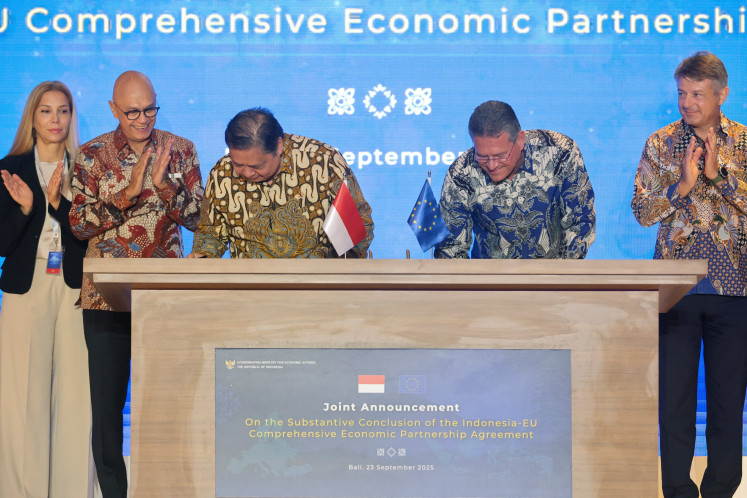Popular Reads
Top Results
Can't find what you're looking for?
View all search resultsPopular Reads
Top Results
Can't find what you're looking for?
View all search resultsRupiah may strengthen on increased dollar supply
The central bank expects the rupiah to strengthen in the “medium term” due in part to an excess supply of dollars, as the US central bank prints money to keep borrowing costs down in the US economy
Change text size
Gift Premium Articles
to Anyone
The central bank expects the rupiah to strengthen in the “medium term” due in part to an excess supply of dollars, as the US central bank prints money to keep borrowing costs down in the US economy.
Bank Indonesia (BI) governor Boediono said Friday the rupiah would strengthen as the dollar weakened against other currencies.
“The general sentiment has moved to (dollar supply) being quite stable on the global level, affecting the (southeast Asian) region and us.”
Boediono did not mention specific levels (of supply stability).
On Friday, the rupiah rose 1.9 percent this week to 11,760 per dollar at 4:54 p.m. in Jakarta, Bloomberg reported. The currency has earlier weakened 7.3 percent this year.
The Federal Reserve on March 18 said it would spend $1 trillion to buy company and government bonds to keep borrowing costs down in the world’s biggest economy.
Similar moves are likely from by the Bank of Japan and the Bank of England.
Boediono said the Fed’s move would eventually lead to an oversupply of dollars, which would return to emerging markets, weakening the greenback against other currencies.
“Seeing the medium term, the dollar is likely to weaken against other currencies. But we don’t know when,” he said.
Market concerns over slumping exports and a rapid outflow of short-term foreign capital have caused downward pressures on the rupiah over the past few months.
Efforts however have been made to help bolster Bank Indonesia’s foreign exchange reserves, including swap agreements with other countries, as a first line of defense and thus to increase confidence in the local currency.
Analysts however did not share Boediono’s optimism on the rupiah.
Mirza Adityaswara, the chief economist of Bank Mandiri, Indonesia’s largest bank by assets, said the dollar might in fact gain further as companies were still in the process of deleveraging.
“Theoretically, printing money will cause inflation; a country with inflation tends to have its currency weaken. But (US) companies are still in the deleveraging process, selling assets in emerging countries, taking dollars with them,” he said.
“So, which one is greater? Printing dollars or the deleveraging process?” he asked.
Helmi Arman, an economist at Bank Danamon, said the rupiah might still weaken due to the deleveraging process.
“The risk the rupiah may weaken is there, as the deleveraging process hasn’t finished and it may be more dominant (than the Fed move).”
He also said Indonesia’s corporate overseas debts might pose risks to the forex reserves, although they “won’t be big enough to make the rupiah volatile”.
Indonesia’s corporate overseas debts maturing in 2009 amount to $22.6 billion, or almost 42 percent of the country’s $53.9 billion of foreign exchange reserves, according to the central bank.
BI said $17.4 billion of the debts were short-term loans and $5.2 billion were bankers’ acceptances and trade credits.
The debts, if they cannot be rolled over, may pose a threat to the rupiah.
Currency analyst Farial Anwar said overseas debts were among the factors contributing to the weakening rate of rupiah against the dollar.
But BI deputy governor Hartadi A. Sarwono said 31 percent of the $17.4 billion debts were owed to parent companies, meaning “the companies may still get debt rollovers”.










